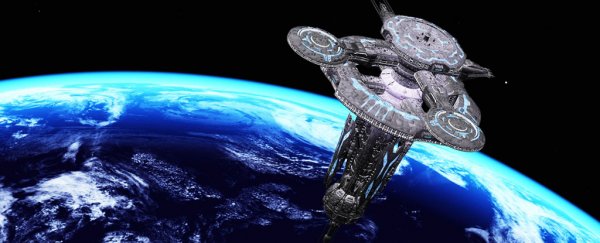The European Space Agency (ESA) has announced an ambitious plan to build a space base between Earth and the Moon, which astronauts could use as a kind of halfway house on lunar missions – or as a launchpad for new explorations elsewhere in the Solar System.
While details on the proposal aren't yet available, the ESA says this 'human outpost' in space could be built within the decade – and the organisation will be actively considering the plan at a conference later in the year.
In addition to providing a "crossroads in space" to help with lunar research missions and other space-faring expeditions, this base – situated approximately halfway between Earth and the Moon – could also serve as a successor to the International Space Station (ISS).
The ISS is scheduled to come out of service in 2024, after some 26 years of active duty, and it's not yet clear how space agencies around the world plan to fill the void left by this massively important space research facility.
"Let me take you on a thought experiment about 10 years into the future," David Parker, the ESA's Director of Human Spaceflight and Robotic Exploration, told the media at a press conference in Germany this week, celebrating the safe return of British astronaut Tim Peake to Earth.
"After 25 years of service, the International Space Station is coming to the end of its life, but now 1,000 times further out in space a new star has risen," he added. "A human outpost in deep space, located far out, where Earth and [the] Moon's gravity balance, a kind of crossroads in space."
According to Parker, the remote location of the space base would mean it could serve as much more than just a replacement for the ISS, enabling new kinds of scientific study in space – and chiefly, far greater access to the Moon.
"This is our deep space habitat, a new place to live and learn how to work in space, a kind of base camp for exploring the Solar System and reaching back down to the surface of the Moon," he said. "[Astronauts] can look down on a Moon untroubled by humans in more than 50 years. We want to go back there, we've barely scratched the surface."
Discussions on the space base will take place later in the year, with the ESA hosting a conference in Lucerne, Switzerland, to be attended by European ministers. And it's an idea that very much has the backing of Tim Peake, who's still physically recovering from his six-month space trek – the effects of which he described as feeling like "the world's worst hangover".
"We're at a stage now [where] we're ready for the next missions beyond the space station. Absolutely, without a shadow of a doubt. We've made enormous progress," Peake told media in Germany. "It's extremely important that the UK is involved in all of that. We need to give our industry a chance to develop what they need to support human spaceflight. If we're not involved now then we are simply going to miss the boat."
But the UK missing the boat on ESA missions like the proposed space base is a definite possibility – and one which depends highly on the results of this week's historic Brexit referendum, in which the UK will vote on whether to stay within the European Union (EU).
The proposed space base is one of many current proposals from international space agencies involving the Moon, signalling a 'return' to a place that once occupied the centre stage in humanity's space explorations. NASA, the ESA, and Russia all have their own plans to send humans to the Moon – or establish lunar colonies on the surface – within the next decade or shortly after.
It's an exciting time to be watching this all unfold!
